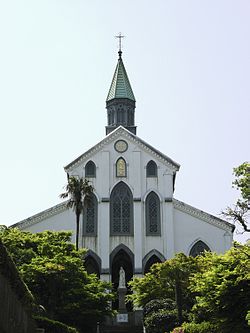Ōura Cathedral
| Basilica of the Twenty-Six Holy Martyrs of Japan | |
|---|---|
| 日本二十六聖殉教者堂 | |
 |
|
| Location | Nagasaki, Japan |
| Denomination | Catholic |
| Architecture | |
| Completed | 1864 |
The Basilica of the Twenty-Six Holy Martyrs of Japan (日本二十六聖殉教者堂) also Ōura Church (大浦天主堂 Ōura Tenshudō) is a Roman Catholic minor basilica and Co-cathedral in Nagasaki, Japan, built soon after the end of the Japanese government's Seclusion Policy in 1853. It is also known as the Church of the 26 Japanese Martyrs. It was for many years the only Western-style building declared a national treasure, and is said to be the oldest church in Japan.
In 1863, two French priests from the Sociéte des Missions Étrangères, Fathers Louis Furet and Bernard Petitjean, landed in Nagasaki with the intention of building a church honoring the Twenty-Six Martyrs of Japan, nine European priests and seventeen Japanese Christians who were crucified in 1597 by order of Toyotomi Hideyoshi. The church was finished in 1864. Constructed by the master carpenter of the Glover Residence, Koyama Hidenoshin, it was originally a small wooden church with three aisles and three octagonal towers. The present structure is a much larger Gothic basilica that dates from around 1879. This version was built of white stuccoed brick with five aisles, vaulted ceilings, and one octagonal tower. The design most likely came from a Belgian plan used by Catholic missionaries in an earlier church built in Osaka. The stained glass windows were imported from France.
On March 17, 1865, shortly after the completion of the original cathedral, Father Petitjean saw a group of people standing in front of the cathedral. They indicated to the priest that they wanted him to open the doors. As the priest knelt at the altar, an old woman from the group approached him and said "We have the same feeling in our hearts as you do. Where is the statue of the Virgin Mary?" Petitjean discovered that these people were from the nearby village of Urakami and were Kakure Kirishitans, descendants of early Japanese Christians who went into hiding after the Shimabara Rebellion in the 1630s. A white marble statue of the Virgin Mary was imported from France and erected in the church to commemorate this event. The bronze relief in the courtyard below the church shows the memorable scene of the discovery. Before long, tens of thousands of underground Christians came out of hiding in the Nagasaki area. News of this reached Pope Pius IX, who declared this "the miracle of the Orient."
...
Wikipedia
